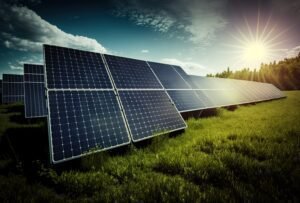Floating solar farms have emerged as a groundbreaking solution to the challenges posed by land scarcity for conventional solar installations. By utilizing water bodies such as lakes, ponds, reservoirs, and even the open sea, these innovative systems open up new possibilities for renewable energy generation. In this comprehensive guide, we delve deep into the technical considerations involved in the design and implementation of floating solar farms, exploring every aspect from location selection to environmental impact mitigation.
Location and Site Selection
The success of a floating solar project hinges on selecting an optimal location. Engineers must meticulously assess various factors to ensure the viability and efficiency of the installation. Water depth, wind patterns, and proximity to grid connections are paramount considerations. Additionally, environmental factors, including impact on aquatic life and adherence to land use restrictions, play a pivotal role in site selection. By conducting thorough assessments and leveraging advanced analytical tools, engineers can identify sites that offer optimal conditions for floating solar deployment, maximizing energy generation potential while minimizing environmental impact.
Floating Platform Design
Designing the floating platforms is a critical aspect that demands a meticulous balance between buoyancy, stability, and durability. Engineers explore a range of materials, including high-density polyethylene and reinforced concrete, to construct platforms tailored to specific location requirements. Modular designs that facilitate easy installation, scalability, and maintenance are favored, allowing for efficient deployment and adaptation to varying site conditions. Advanced computational modeling techniques enable engineers to optimize platform designs, ensuring structural integrity and long-term performance.
Solar Panel Selection
Choosing suitable solar panels is vital for maximizing energy output and ensuring long-term performance. Engineers evaluate various factors, including panel efficiency, durability, and resistance to environmental factors such as humidity and salinity. Innovations such as bifacial solar panels, capable of capturing sunlight from both sides, are gaining prominence in the floating solar landscape, offering increased efficiency and versatility. By selecting high-quality panels optimized for marine environments, engineers can enhance the overall performance and reliability of floating solar systems.
Anchoring Systems
Ensuring the stability of floating solar arrays necessitates robust anchoring systems capable of withstanding dynamic water conditions and adverse weather events. Engineers employ advanced anchoring mechanisms designed to accommodate variations in water levels, wave action, and environmental dynamics. Adjustable anchoring systems provide flexibility, allowing for seamless adaptation to changing conditions and ensuring the long-term stability and integrity of the installation.
Electrical Components
The electrical components of a floating solar system, including inverters, transformers, and power transmission infrastructure, require careful consideration to ensure reliable performance in marine environments. Engineers prioritize the use of corrosion-resistant materials and effective insulation to mitigate the impact of saltwater exposure and environmental degradation. By implementing advanced monitoring and control systems, engineers can optimize energy production and minimize downtime, maximizing the overall efficiency and reliability of floating solar installations.
Environmental Impact and Mitigation
Mitigating the environmental impact of floating solar farms is integral to their sustainable implementation. Engineers employ a variety of measures to minimize disruption to aquatic ecosystems and preserve water quality. Strategies such as anti-reflective coatings on solar panels help reduce glare and minimize visual impact, while the creation of artificial habitats promotes biodiversity and ecological resilience. By monitoring environmental indicators and implementing adaptive management strategies, engineers can ensure that floating solar installations coexist harmoniously with their surrounding ecosystems.
Maintenance and Cleaning
Regular maintenance is essential for maximizing the longevity and efficiency of floating solar systems. Engineers develop innovative solutions for automated cleaning mechanisms, addressing challenges such as biofouling that can impact both floating platforms and solar panels. By implementing proactive maintenance protocols and leveraging remote monitoring technologies, engineers can detect and address issues in real-time, minimizing downtime and optimizing energy production.
Floating solar farms represent a paradigm shift in renewable energy deployment, offering a sustainable and scalable solution to the challenges of land scarcity and environmental impact. By adopting a multidisciplinary approach that integrates expertise in engineering, environmental science, and renewable energy, engineers can unlock the full potential of floating solar technology, paving the way for a more sustainable and diversified energy future.
As technology advances and innovation continues, the potential for harnessing solar power above the waves continues to grow, driving further progress towards a cleaner, more sustainable energy landscape. With careful planning, meticulous design, and strategic implementation, floating solar farms have the power to revolutionize the way we generate and utilize renewable energy, ensuring a brighter and more sustainable future for generations to come.





